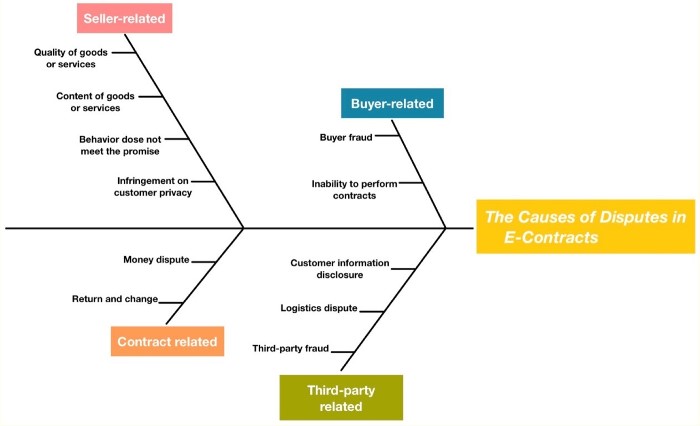using Multiple Analysis Methods
STUDENT PAPER
By Feiran Liu
SKEMA Business School
China and Lille, France
ABSTRACT
This article’s aim is to analyze the causes of disputes in E-contract and the alternative solutions to these disputes. There are three questions presented to promote the analysis which are how do buyers and sellers reach a consensus in a dispute? In the dispute, how to maintain the legal status of buyers and sellers equal? What is the most notable problem in dispute resolution? The analysis is carried out by the cause and effect diagram in root cause analysis, the Non-Dimensional Scaling Technique, a Non-Compensatory approach, the addictive weighting technique and the Pareto analysis. After analysis, six resolutions for resolving e-contract disputes have been proposed, and it is found that Buyer resolves independently is the best solution.
Keywords: E-contract, causes of disputes, e-contract disputes, conflicts, alternative resolutions
INTRODUCTION
“Nowadays with China’s e-commerce develops rapidly, the numbers of e-contract disputes increase significantly”[1]. “Only in one province of China, Guangdong Province from 2011 to 2013, the average annual growth rate of e-contract disputes was 24%, and the average annual growth rate of new types of cases has reached 75%.”[2] The data showed that from May 2014 to April 2015, the E-commerce Trial Collegiate Panel in Guangdong “had accepted 19 e-contract dispute cases and concluded 14 cases;”[3] And from May 2015 to April 2016, 266 cases of the same type were accepted and 192 cases were concluded; From May 2016 to April 2017, 107 cases of the same type were accepted and 148 cases were concluded [4]. Among these e-contract cases, the online shopping contract disputes accounted for more than 80%, and the remaining balances were other disputes such as intellectual property rights violations and privacy violations. In view of the large proportion of online shopping contract disputes, this report mainly emphasis on the analysis of the causes of online shopping contract disputes.
Generally speaking, the causes of e-contract disputes are numerous, however the dispute causes are mainly concentrated, and there are certain commonalities. Therefore, by the help of data in recent years, the causes of e-contract disputes are principally determined and classified into the following four categories according to their characters: seller related, buyer related, contract related, third party related. There are sub categories (11 in total) for each cause, which will be further studied according to the cause and effect diagram in root cause analysis (see figure 1).
 Figure 1. Cause-and-Effect diagram[5]
Figure 1. Cause-and-Effect diagram[5]
E-commerce can facilitate people’s lives which is a manifestation of social development and progress. However, in the process of e-commerce transactions, conflicts are inevitable because of the different positions and opinions between the contract parties, and if conflicts are not resolved in time, it is easily to convert into disputes. Disputes of e-contract belongs to the scope of e-commerce projects, and their existence are a crucial obstacle to the completion of e-commerce projects to some extent. But according to Fenn et al. (1997) “conflict and dispute are two distinct notations. Conflict exists wherever there is incompatibility of interest. Conflict can be managed, possibly to the extent of preventing a dispute resulting from the conflict” [6]. Hence, analyzing the causes of disputes could promote the exploration of the underlying source of conflicts, which can help e-commerce managers to evade and manage, also helps to improve the e-commerce project contracts and regulations. Thus it will promote the completion of electronic projects and alleviate the current sudden increase in the number of electronic dispute cases in China to a certain extent.
This article aims to analyze the causes of conflicts in e-contracts and provide solutions. To achieve this goal, detailed analysis will be conducted in the following articles. At the end of the article, readers will have a clear and crystal understanding of the causes of disputes in e-contracts. And more importantly, this article will provide practical suggestions and solutions in order to obtain better solutions of the e-contract disputes in actual e-commerce projects.
More…
To read entire paper, click here
Editor’s note: Student papers are authored by graduate or undergraduate students based on coursework at accredited universities or training programs. This paper was prepared as a deliverable for the course “International Contract Management” facilitated by Dr Paul D. Giammalvo of PT Mitratata Citragraha, Jakarta, Indonesia as an Adjunct Professor under contract to SKEMA Business School for the program Master of Science in Project and Programme Management and Business Development. http://www.skema.edu/programmes/masters-of-science. For more information on this global program (Lille and Paris in France; Belo Horizonte in Brazil), contact Dr Paul Gardiner, Global Programme Director paul.gardiner@skema.edu.
How to cite this paper: Liu, F. (2019). An Analysis of the Resolution of Disputes in E-contracts using Multiple Analysis Methods, PM World Journal, Vol. VIII, Issue VIII, September. Available online at https://pmworldlibrary.net/wp-content/uploads/2019/09/pmwj85-Sep2019-Liu-resolutions-of-disputes-in-econtracts.pdf
About the Author

Feiran LIU
Zibo, China
![]()
Feiran LIU is a student of MSc Project and Programme Management & Business Development at SKEMA Business School in Lille Campus. Born in Zibo, China, she has obtained a bachelor’s degree in Water Supply and Drainage Science and Engineering from Qingdao Technological University. During her bachelor’s degree, she had a short internship at Shandong Tianwei Engineering Technology Co., Ltd. and Licunhe Wastewater Treatment Plant. She has a certain knowledge reserve for engineering design and sewage treatment, and now she is studying for project management in SKEMA Business School in France.
Feiran lives in Zibo, China, and can be contacted at feiranatasha@hotmail.com.
To view more information about Feiran, check out her LinkedIn page at: https://www.linkedin.com/in/%E6%96%90%E7%84%B6-%E5%88%98-78a238173/
[1] Nanfang Daily. 10 e-commerce disputes involving 7 online shopping. Retrieved from http://tech.sina.com.cn/roll/2017-06-19/doc-ifyhfpat5274601.shtml
[2] Nanfang Daily. 10 e-commerce disputes involving 7 online shopping. Retrieved from http://tech.sina.com.cn/roll/2017-06-19/doc-ifyhfpat5274601.shtml
[3] Nanfang Daily. 10 e-commerce disputes involving 7 online shopping. Retrieved from http://tech.sina.com.cn/roll/2017-06-19/doc-ifyhfpat5274601.shtml
[4] Nanfang Daily. 10 e-commerce disputes involving 7 online shopping. Retrieved from http://tech.sina.com.cn/roll/2017-06-19/doc-ifyhfpat5274601.shtml
[5] By Author.
[6] Emre Cakmak and Pinar Irlayici Cakmak. An analysis of causes of disputes in the construction industry using analytical network process. Retrieved from https://www.sciencedirect.com/science/article/pii/S1877042813050738









